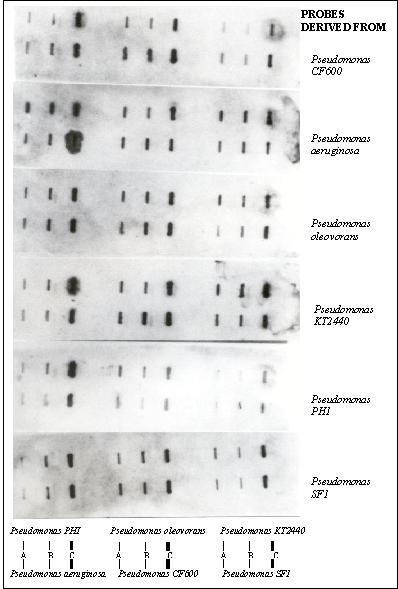Figure 8

Demonstration of specificity of PCR amplified product for genus Pseudomonas by Slot-Blot hybridization data. PCR product was generated using signature primer as shown in Figure 7. Biotinylated probes were generated from PCR amplified 150 bp products using the BioPrime DNA Labeling Kit, Gibco BRL, USA. Six probes were derived using six different Pseudomonas strains as mentioned on the right panel of the figure. The same six strains were used as templates in the hybridization as shown in the schematic representation at the bottom of the figure. Each probe was tested against all six strains. The cultures were grown overnight at 30°C and diluted to yield 1000, 5000 and 10,000 cells per 100 μl of sterile double distilled water. This was transferred to a nylon membrane using the Slot-Blot apparatus at positions A, B and C respectively, where A represents 1000 cells, B, 5000 cells and C represents 10,000 cells. The spotted membranes were immersed in SDS/BSA hybridization buffer (0.3 ml/cm2 of membrane). Hybridization was carried out at 60°C in a hybridization oven, Amersham Pharmacia Biotech Ltd., UK. Hybridization signals were detected using the Photogene Nucleic Acid Detection System Version-2 (Gibco-BRL, USA), as per the manufacturer's instructions with high stringency washing. Chemiluminiscent signals were quenched on Kodak: X-omat film after exposure of 30 min. The negative controls used were E. coli, Salmonella, Vibrio, Shigella and Staphylococcus as used in Figure 7 to show the specificity of probe. There were no hybridization signals observed in any of the negative controls (data not shown) even after overnight exposure.